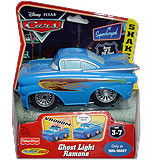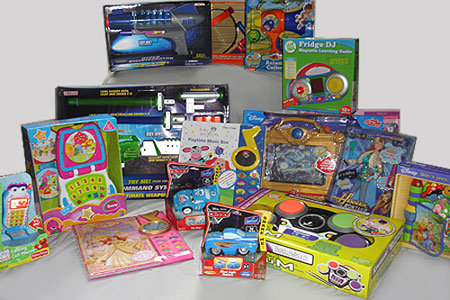Toy safety. It's been a hot issue this year. As it does every year, the Sight & Hearing Association cautions parents to watch out — or rather listen — for another toy danger: noisy toys.
In the organization's latest Noisy Toys study, 15 of 20 toys sounded off over 100 decibels. At that level, a child's hearing is at risk in less than 15 minutes of playing time.
 For the 10th year, the nonprofit organization and researchers from the University of Minnesota tested toys — taken right off retailers' shelves — for potentially dangerous sound levels. All of the toys measured over 90 dB directly at the speaker of the toy. And 15 of the 20 are meant for children three years or younger.
For the 10th year, the nonprofit organization and researchers from the University of Minnesota tested toys — taken right off retailers' shelves — for potentially dangerous sound levels. All of the toys measured over 90 dB directly at the speaker of the toy. And 15 of the 20 are meant for children three years or younger. The top offender on this year's list, Cars Ghost Light Ramone by Fisher Price, blared at 118.5 dB(A) — loud enough to risk hearing damage in 15 seconds. SRM Entertainment's Power Gear Extreme Command System topped out at 114.5. Cars the King and Little Einsteins Create a Masterpiece, both by Fisher Price, measured at 113.5 and 112.3, respectively. All of those toys are loud enough to risk hearing damage in less than one minute.
Sounds that are 85 dB or louder can permanently damage your ears. The louder the sound, the less time it takes to cause damage. For example, a sound at 85 dB may take as long as eight hours to cause permanent damage, while a sound at 100 dB can start damaging hair cells after only 15 minutes of listening. According to guidelines by the National Institute for Occupational Safety and Health (NIOSH), part of the Centers for Disease Control, the permissible exposure time (the amount of time you should listen) is cut in half with every 3 decibels over 85 dB.

Because of a child's shorter arm span, toys are often potentially more dangerous to hearing because children hold them closer to their ears. In the Sight & Hearing Association study, the toys were repeatedly tested at distances simulating how a child might hold the toy, directly near the ear (0 inches) and at arm's length (10 inches). A soundproof acoustic chamber was used to ensure accurate measurements.
Until 2004, there were no regulations in the United States regarding the loudness of toys. An acoustics standard (ASTM F963), adopted and revised in March 2004 by ASTM International, states that a hand-held, table-top or crib toy cannot exceed 90 dB 25 cm (approx. 10 in.) from the surface of the toy. Compliance with the standard is voluntary.
Directly at the speaker of the toy, all of the toys tested this year measured louder than 90 dB. At 10 inches from the toy's surface, two of the toys measured louder than 90 dB: the Power Gear Hyper Disintegrator (92 dB) and Blue's Clues Learning Lessons Computer (92 dB).
Unlike with choking hazards and other injuries, there are no injury statistics on toys and hearing loss. That's because noise-induced hearing loss is nearly impossible to track its origination.
To protect a child's hearing, the Sight & Hearing Association offers the following tips:
- Listen to a toy before you buy it. If it sounds loud to you, it's too loud for your child.
- Report a loud toy. Call the Consumer Product Safety Commission at 800/638-2772 or the Sight & Hearing Association at 800/992-0424, or contact us by e-mail at ReportAToy@sightandhearing.org.
- Put masking or packing tape over the speaker on the toy. This will help reduce the volume.
- Buy toys with volume controls.
View the 2007 Noisy Toy List
Taken from www.sightandhearing.org/news/healthissue/archive/hi_1207.asp.

